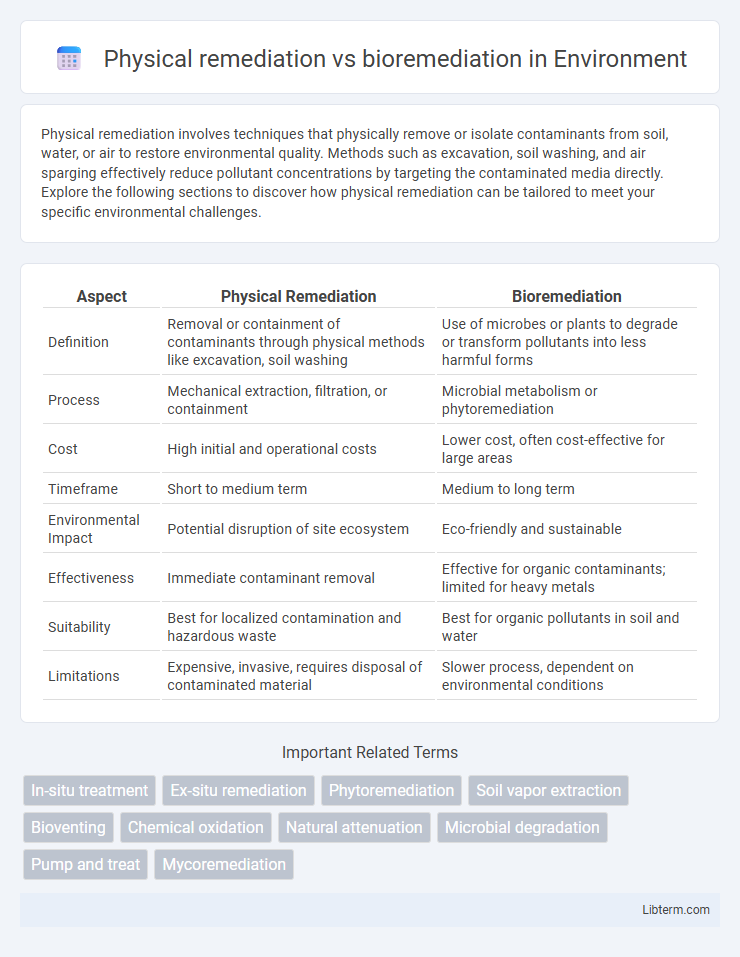Physical remediation involves techniques that physically remove or isolate contaminants from soil, water, or air to restore environmental quality. Methods such as excavation, soil washing, and air sparging effectively reduce pollutant concentrations by targeting the contaminated media directly. Explore the following sections to discover how physical remediation can be tailored to meet your specific environmental challenges.
Table of Comparison
| Aspect | Physical Remediation | Bioremediation |
|---|---|---|
| Definition | Removal or containment of contaminants through physical methods like excavation, soil washing | Use of microbes or plants to degrade or transform pollutants into less harmful forms |
| Process | Mechanical extraction, filtration, or containment | Microbial metabolism or phytoremediation |
| Cost | High initial and operational costs | Lower cost, often cost-effective for large areas |
| Timeframe | Short to medium term | Medium to long term |
| Environmental Impact | Potential disruption of site ecosystem | Eco-friendly and sustainable |
| Effectiveness | Immediate contaminant removal | Effective for organic contaminants; limited for heavy metals |
| Suitability | Best for localized contamination and hazardous waste | Best for organic pollutants in soil and water |
| Limitations | Expensive, invasive, requires disposal of contaminated material | Slower process, dependent on environmental conditions |
Introduction to Environmental Remediation
Environmental remediation addresses contamination in soil, water, and air through methods like physical remediation and bioremediation. Physical remediation involves mechanical or chemical processes such as excavation, soil washing, and pump-and-treat techniques to remove or isolate pollutants quickly. Bioremediation uses microorganisms or plants to naturally degrade or transform contaminants, offering a cost-effective and sustainable solution for organic pollutants and certain heavy metals.
Defining Physical Remediation
Physical remediation involves the direct removal or containment of contaminants from soil or water using techniques such as excavation, soil washing, or solidification. It targets pollutants by physically isolating or extracting them to prevent environmental exposure and limit further spread. This method contrasts with bioremediation, which relies on biological processes to naturally degrade or transform contaminants over time.
Understanding Bioremediation
Bioremediation leverages microorganisms to degrade pollutants naturally, making it a cost-effective and environmentally friendly alternative to physical remediation, which involves mechanical removal or isolation of contaminants. This method specifically targets organic pollutants such as petroleum hydrocarbons, chlorinated solvents, and heavy metals through microbial metabolism under controlled conditions. Understanding bioremediation enhances site-specific treatment design by optimizing factors like nutrient availability, oxygen levels, and temperature to maximize microbial activity and contaminant breakdown.
Mechanisms of Physical Remediation
Physical remediation relies on mechanisms such as soil excavation, sediment dredging, and pump-and-treat systems to remove contaminants from the environment. These methods physically separate or extract pollutants through processes like filtration, sedimentation, or adsorption. Techniques such as air sparging and soil vapor extraction utilize pressure and airflow to volatilize and capture hazardous substances, enabling their removal without relying on biological activity.
Biological Processes in Bioremediation
Biological processes in bioremediation involve the use of microorganisms such as bacteria, fungi, and algae to degrade hazardous contaminants into less toxic or harmless substances. These microorganisms metabolize pollutants through enzymatic reactions, converting organic compounds like hydrocarbons, pesticides, and heavy metals into water, carbon dioxide, and biomass. Bioremediation offers a sustainable and cost-effective alternative to physical remediation techniques by enhancing natural attenuation and supporting in-situ pollutant detoxification with minimal environmental disturbance.
Key Advantages of Physical Remediation
Physical remediation offers the advantages of rapid contaminant removal and precise control over the treatment process, making it effective for immediate site stabilization. Techniques such as soil excavation, air sparging, and pump-and-treat systems can directly extract or isolate pollutants from soil and groundwater. This approach is particularly beneficial for sites with high contaminant concentrations where quick action is critical to prevent further environmental damage.
Benefits of Bioremediation Approaches
Bioremediation leverages natural microorganisms to degrade hazardous contaminants, offering an eco-friendly and cost-effective alternative to physical remediation methods that often require extensive excavation and disposal. This approach enhances soil and water quality by restoring ecosystems without generating secondary waste, making it particularly beneficial for treating complex pollutants such as petroleum hydrocarbons and heavy metals. Bioremediation's adaptability and sustainability contribute to its growing preference in environmental cleanup strategies worldwide.
Limitations of Physical Remediation Methods
Physical remediation methods for environmental cleanup, including excavation, soil washing, and air sparging, face limitations such as high operational costs and disruption of ecosystems. These techniques often fail to completely remove contaminants from subsurface environments, leading to potential residual pollution. Additionally, physical methods may not be effective for treating widespread or low-concentration pollutants, restricting their applicability in large-scale remediation projects.
Challenges in Bioremediation Implementation
Bioremediation faces challenges such as the variability in microbial activity due to environmental factors like temperature, pH, and nutrient availability, which can limit the degradation of pollutants. The presence of toxic substances or heavy metals may inhibit microbial growth, complicating the process. Scaling up from laboratory to field conditions often encounters difficulties in maintaining optimal microbial populations and ensuring uniform contaminant bioavailability.
Comparative Analysis: Physical Remediation vs Bioremediation
Physical remediation involves removing or isolating contaminants through methods like excavation, soil washing, or thermal treatment, providing rapid results but often with high costs and environmental disturbance. Bioremediation leverages microorganisms to degrade pollutants naturally, offering a cost-effective and sustainable solution, though it requires longer time frames and is limited by site conditions such as temperature and oxygen availability. Comparative analysis shows physical remediation excels in immediate hazard reduction, whereas bioremediation is preferable for long-term restoration of contaminated sites with minimal ecological impact.
Physical remediation Infographic

 libterm.com
libterm.com